gle Adsense

Through the years, Google Adsense has provided marketers a way to earn money and make a living using their websites. It has proven to be one of the most popular ways to make money online.
How does Google Adsense work?
Google Adsense is an advertising network owned by search engine giant Google.In a nutshell, you need to embed a Javascript provided to you by the platform on your site. The script will show contextual ads that are relevant to your content.
You can make money off the ads if people click on them. (That's right, people don't have to actually buy anything, you get paid when someone simply clicks the ad on your website).
Contents [hide]
- 1 How does Google Adsense work?
- 2 How to increase the performance of your ad units
- 3 How to keep your Google Adsense account from getting banned
- 4 Case studies of successful Google Adsense performers
- 5 Wrapping it all up
How to measure ad performance
Generating money from Google Adsense depends on three important factors: the CPC, CTR, and RPM.CPC, also known as cost per click, refers to the amount of money you will receive if your visitors click on your ad.
As publishers, you have no control over how much you will receive for each click on your ad. It ultimately depends on the competition in your domain's niche that dictates the pricing, which could also change over time. Nonetheless, you can attract the best possible ads for your site using tactics that will be discussed in a different section below.
On the other hand, CTR or click-through rate refers to the percentage of visitors clicking on your ads while on your site.
CTR is important if you want to earn from Google Adsense truly. While CPC determines how much you will earn, you have very little control over the variables that determine the costs of the ads that will appear on your site. Your CTR is highly dependent on controlled variables or tactics that you can use to increase your ad performance which will also be discussed later.
Both metrics help you make sense of your RPM or revenue per 1,000 impressions. Impression describes the activity that takes place on the site and server every time an ad is fetched.
To compute the RPM, you need to divide your estimated earnings by the number of impressions (how many times an ad was seen on your website) and multiply the quotient by 1,000.
Measuring your potential earnings through RPM reveals to you the bigger picture that CPC and CTR can't show. Essentially, RPM is showing how much money you make per visitor. Ultimately, it doesn't matter if your site is showing low-paying ads. The important thing is that you optimize your ads for increased performance and higher revenue.
Different ad options
Since you need to get people to click on your ads to make money, Google Adsense offers different ad options that you can show on your pages.- Text – Also known as “sponsored links,” the ads will appear as one or two lines of text format which may include the title of the ad and the physical address (for local businesses).
- Display ads – The ads will appear in graphic format. You can choose from different sizes for your display ads, which will depend on where you wish to place it on your page.
- Rich media – The ads will appear in HTML, Flash, and video format.
- Animated image – The ads will appear as dynamic images. To show this on your site, you need to enable image ads.
- Link units – They will show a list of topics related to your content. Once your visitors click on them, they will be directed to a page of Google ads related to the topic. You can only make money from this ad type if visitors click on the ads after clicking on the list of topics.
- 336×280 large rectangle
- 300×250 medium rectangle
- 728×90 leaderboard
- 300×600 half page
- 320×100 large mobile banner (on mobile)
How to increase the performance of your ad units
You can't just randomly slap your Google Adsense on your page. You need to identify the optimal places where you can set up your ads to appear on your site pages. Doing so allows you generate more clicks on your ads and drive more revenue.Below are a few different options for optimizing your ad units on your site.
Maximize Earnings: I use a free ad tester called Ezoic which makes testing different ad placements very simple. Click here to try it out.
Place them “above the fold”
This term refers to the part of your website page that is visible without having to scroll down. In other words, this is going to be the very top of your page.Placing your ad above the fold makes it difficult for users to ignore.
However, it is ill-advised to feature only your ad above the fold and push down your content. Google has made it clear that websites with top heavy ads could get penalized. So, make sure you have content on the top of your page as well…not just ads.
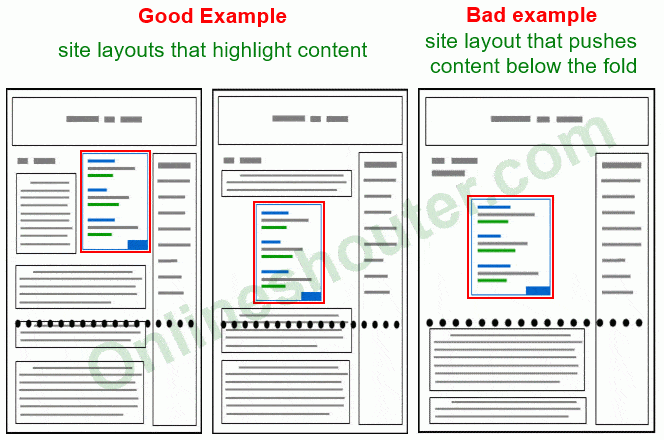
Test your color strategy
Color is a major component of your ad unit. Your choice of colors of your ads will determine how they will perform over time.You can approach your ad placements in different ways:
- Blend – If you want your ad units to look similar to your content. However, there still needs to be a clear delineation between ads and content on your page as it is considered a policy violation.
- Contrast – If you want your ad units to stand out from your content.
- Complement – If you want your ad units to use colors found on your site but not match the background and borders
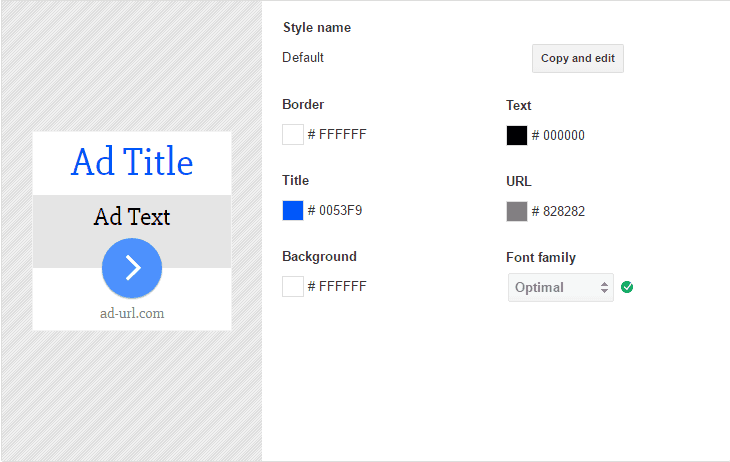 Therefore, what you can do is test which of the three works best for
your site. Edit the ads based on the approach you want to take and run
them for a period. Keep playing around with the ads to see which
approach makes you the most money over time.
Therefore, what you can do is test which of the three works best for
your site. Edit the ads based on the approach you want to take and run
them for a period. Keep playing around with the ads to see which
approach makes you the most money over time.Put them near your CTAs
Call to action or CTA is an instruction that asks site visitors to perform a particular action on your page.Examples of CTAs are as follows:
- Buttons – The idea behind buttons on a page is for visitors to click on them and direct them to a different page.
- Forms – Visitors will be asked to fill out the form based on the objectives of the content on the page.
- Social sharing tools – For blog posts and resource pages, readers can share them on Facebook and Twitter, among others, to their followers.
However, make sure that the ad units that appear beside the CTAs do not attract attention away from your CTAs. While earning from ad clicks is nice, your page's CTA will likely be more important than everything else.
Review & Optimize Your Ads
You shouldn't get too comfortable with your ad layouts. One of the things I've done for a while now in online marketing, is perfect the art of “testing” my monetization methods. Not only do I test different ad networks outside of Adsense, but I am always revising just about everything to do with my ads.I set a monthly schedule and once per month, I go in and compare revenue for my best performing ads from the prior month. If I have lower performing ads, I will shut them down and new formats and new ad placements.
It's easy to get comfortable with a certain amount of revenue if you are making money online, but you should always be testing to ensure you can maximize your revenue streams.
Pick a WordPress Theme That Allows Multiple Display Ad Locations
If you are using an “out of the box” WordPress theme, chances are that your display options for ads are pretty limited. Luckily, there are more WordPress themes in the market now that allow for greater flexibility with regards to ad positioning. It used to be that you really could only do an in-content ad and a sidebar. Now it seems you can test all sorts of different layouts.While getting a custom theme designed is generally always more beneficial, you can still do a lot of great testing and layout options by picking a decent premium theme. There are also website “builders” that let you visually build out your pages, giving you greater flexibility with your ad layout positioning.
Choosing a premium theme will give you quite a few options to test your ads, and make sure you are optimizing them on a monthly or bi-monthly basis in order to improve revenue.
Ask visitors to turn off AdBlock
Let's face it – people are averse to ads.As much as possible, they will avoid ads because they disrupt the flow of the content, which is the reason why they visited your site in the first place.
Therefore, some users install ad blockers on their browsers, so they don't have to encounter annoying ads.
While ad blockers may benefit users, you, as a Google Adsense user, won't.
You need to find a way to ad block users so you can serve them ads.
A easy way to do this? Ask them nicely.
A poll conducted by IAB UK reveals that people are more than willing to turn off their ad blocker if the site asked them to.
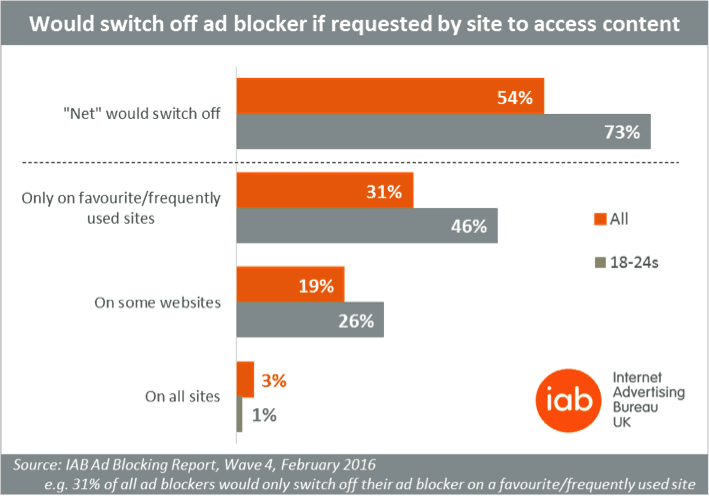 If you are running your site on WordPress, ThemeIsle shares five of the best anti-ad block plugins that you can use. Each plugin has distinct ways of asking visitors to whitelist your site so you can serve them ads.
If you are running your site on WordPress, ThemeIsle shares five of the best anti-ad block plugins that you can use. Each plugin has distinct ways of asking visitors to whitelist your site so you can serve them ads.Paginate your content
The increase of mobile users online over the past couple of years proves that mobile is here to stay. Aside from making your website mobile-friendly, you need to tweak your ad strategy that will cater to your mobile audience.An interesting approach to monetizing your mobile sites through ads is by paginating your content.
 Instead of showing the entire content on a single page, you will only
show bits and pieces of your content. Users can move on to the next
section by going to the next page.
Instead of showing the entire content on a single page, you will only
show bits and pieces of your content. Users can move on to the next
section by going to the next page.The tactic positively impacts your ad performance as explained in this post at AdNgin.
The best reason why you should paginate your content, especially on mobile, is its ability to help increase ad impressions. Every time users click to the next page, the server will fetch the ad to the page again. For example, if you paginate your 1,000-word article into two pages, just like Forbes does, then you can double your impressions as opposed to showing the entire content on a page.
The higher the impressions are, the more chances you can serve contextual ads based on the content on the page. If done correctly, pagination can increase your revenue.
An additional note about pagination
I emphasized doing pagination correctly because it can also bring new problems. For beginners, not everyone is a fan of pagination. Not to mention, it changes how analytics tools will collect data from your site. Instead of taking your content as a single page, it will interpret the paginated content as individual pages in itself.Nonetheless, if you can overcome the roadblocks presented by pagination, you can begin by the downloading the best pagination plugins for WordPress in this WPDean post that you can use on mobile view. Once you have decided which plugin to use, make sure to test and observe the results and how it impact your ad performance.
Learn SEO
I'm sure most of you know the importance of SEO in building a successful website.However, I cannot stress this enough:
Confused About Niche Websites?
Join Niche Pursuits Insider to Get Access To Our Niche Site Training Blueprints + Get Your Questions Answered In Our Members-Only Facebook Group.
Learn More
Join Niche Pursuits Insider to Get Access To Our Niche Site Training Blueprints + Get Your Questions Answered In Our Members-Only Facebook Group.
Learn More
I have covered SEO in depth on this blog and has been a key factor in the success of my Niche Site Projects.
To keep it short, below are the most crucial things you need to remember when doing SEO for your sites:
- Target Low Competition Keywords – If there is one thing that has driven my own success with niche websites, it's targeting keywords that are easy to rank for. By doing proper keyword research to determine what you can feasibly rank for, you can make your life so much easier in terms of SEO.
- Beware of Google's algorithm – Just like Adsense, Google Search is governed by an intricate web of rules. More important, Google always updates its algorithm to serve users with the most relevant pages for their search terms. Some of my projects have been penalized because Google caught on with grey-hat tactics like PBN link building. This is a good thing because it keeps everyone honest and ultimately allows the best sites to rank near the top.
- Always create great content – If there's one thing that withstood Google's constant algorithm updates, it's great content. Google rewards sites that publish actionable, long-form content that resonates with its audience by placing them at a high position in search results.
- Be creative with link building – Backlinks are the very heart of off-page optimization. A lot of sites have tried gamifying search results through shady link building tactics. It worked in the past, but Google has gotten better at catching sites using black-hat techniques. Therefore, you need to find sustainable white-hat strategies for link building to maintain a steady amount of organic traffic.
How to keep your Google Adsense account from getting banned
As mentioned above, there are Google Adsense practices that can get your account suspended. Google is very good at cracking down on users who violate their policies so don't even think of one-upping Google in their own game (i.e. Never click your own ads, or ask anyone else to click on your ads!).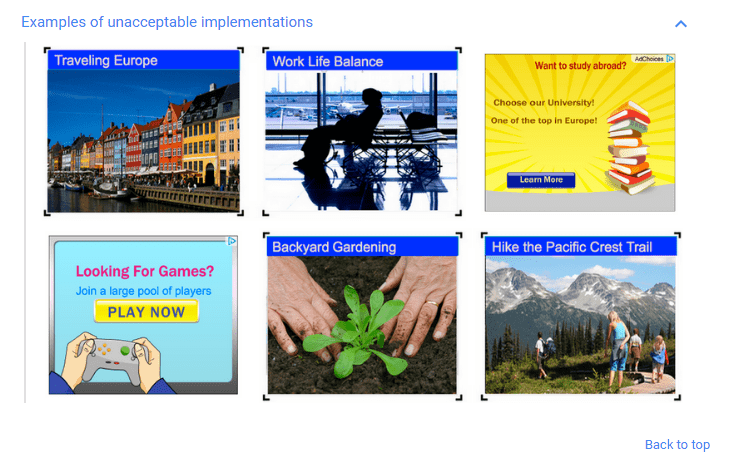 Below are other practices to avoid so you can keep your Adsense account and earn money from their ads:
Below are other practices to avoid so you can keep your Adsense account and earn money from their ads:- Click on your ads – It doesn't count if you as site owner click on your ads in the hope of making money. People in your home clicking on your ads is also a violation. Even if you use a proxy to hide your IP address, there's a good chance you will get caught.
- Hold ad-click contents – This method is a form of begging for clicks, which is against Google policy. Desperately asking for people to click on your ads compromises not only the advertisers but also your site.
- Manually alter the code – If you want to make changes to your Google Adsense code, do it from the Adsense platform. Do not tweak the appearance of the ads by editing the code yourself. Google wants to observe ad performance based on the changes made from Adsense. Alterations made outside of Adsense prevents Google from effectively tracking their progress, thus making it a violation.
- Enlist robots to click ads – Using robots or any automated tool to gamify the system for the purpose of inflating your earnings is illegal. You are also prohibited from using human-generated clicks or trading clicks with other publishers.
- Create site specifically for ads – Part of Google's mission is to promote sites that provide valuable content on their site. If your site is thin on content and is merely used to showcase ads, then you are risking yourself from getting banned.
No one is safe
Even if you feel that you are following Google Adsense policies to a tee, there's still a chance your account can be penalized.I got my account banned in 2012 out of the blue. It was only after a couple of months later after creating a new Adsense account when I found out that my ads are generated an unusually high CTR. Back then, I was using a theme with an aggressive ad placement, which most likely led to lots of clicks.
I highly encourage you to strictly follow Google policies regarding ads. There is no point in going behind Google's back by illegally increasing your ad performance when you will eventually get caught.
Case studies of successful Google Adsense performers
Taking all the best practices mentioned above into account, there is still no guarantee that you will generate a steady income stream from Google Adsense. Other factors such as your ability to drive traffic and rank for your target keywords, among others, are essential skills to make the most out of your ad-infused site.Below are case studies of people who have learned how to make money with Google Adsense.
Harsh Agrawal – $174/month
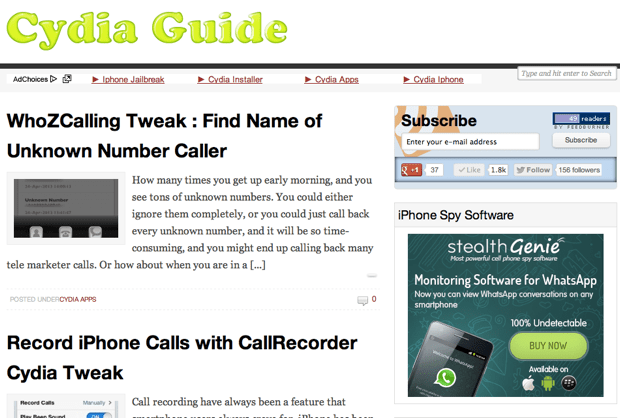 The ShoutMeLoud owner explains how he was able to generate at least
$160 a month from Google Adsense by creating a micro-niche site in this post.
The ShoutMeLoud owner explains how he was able to generate at least
$160 a month from Google Adsense by creating a micro-niche site in this post.Below are key takeaways from Harsh's blueprint that you can apply on your site to increase ad performance:
- Find a niche you are comfortable with – While you cannot dictate the CPC for ads for your niche, you can choose a niche with a high CPC. Also, choose a niche that you are passionate about. Earning money from your site through high-paying ads is great, but you may lose motivation if you are developing a site with a topic you have zero interest in.
- Find keywords for your content – To drive organic traffic to your site; you need to find keywords related to your niche. Ideally, you should optimize for keywords with high search volume and little competition, something that LongTailPro will provide you help with. For writing your content, you can hire from sites like TextBroker to do the writing for you.
- Build links to your pages – In Harsh's example above, he did not create backlinks even though he drove lots of organic traffic to his micro-niche site. However, as part of SEO's best practices, you need to find ways on how to earn links from high-quality sites so you can increase your search ranking for your keywords.
Matthew Paulson – Over $100,000/year
Matt built a profitable network of financial sites. A lot of his success to making money online lies in his ability to attract tons of traffic through unit means. He consistently drives 2.5 million unique visitors a month to his sites. Matt has been able to reap the benefits of not just Google Adsense, but various other monetization methods as well.To learn more about Matt's methods, you can listen to the podcast I conducted with him by clicking here.
Below are takeaways from the podcast:
- Don't rely solely on Google for traffic – While ranking for your keywords of Google search will benefit your site, it's not the only way for you to get traffic. In Matthew's case, only 20% of his total traffic come from organic search. He gets most of his site traffic from places like Twitter and news outlets. In other words, Google is not the only source that can help you drive more visitors.
- Find other ways to earn other than ads – Google Adsense has a low barrier to entry for publishers to generate a sufficient amount of revenue for their sites. However, to truly unlock the key to earning more, you need to think outside of ad networks (like selling your own products, etc).
- Build an email list – What Matt noticed with his visitors is their interest for more in-depth analysis about the stock market. Instead of offering the analysis for free, he only sent them to his subscribers. Matt then set up an opt-in form on his site to collect email addresses of people interested in the content. Building a list allowed him to monetize the analysis exclusive to his subscribers.
Spencer Haws – $10,000/month
Of course, I had to include myself in this post! 🙂My success with Google Adsense started in 2009 when I began creating niche sites with low competition. Taking this route helped me generate lots of traffic from Google, Bing, and Yahoo! at a time.
I built websites using this strategy, which helped me earn a five-figure monthly income.
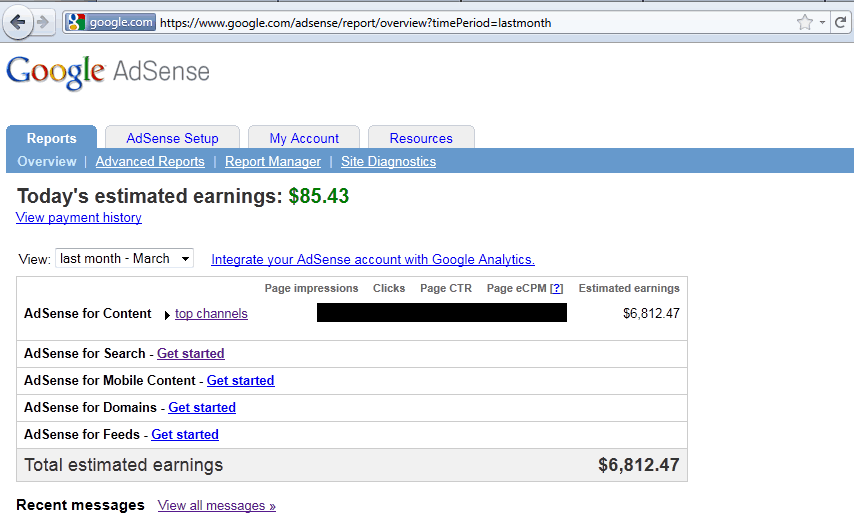
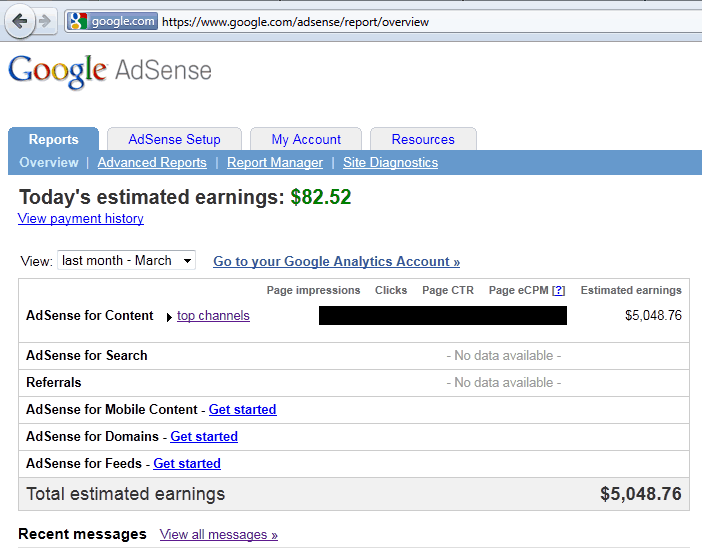
My highs with earning from Google Adsense is not without its lows.
After making over six figures a year from Google Adsense back in 2011, my account was unexpectedly shut down in 2012. You can read the entire epic story of my Adsense account getting shut down here.
Luckily, a few months later, I was able to open a new account and have been earning from Google Adsense ever since. However, this also made me realize that Google holds a lot of power, so it can be important to not rely solely on one source of income.
I now share some of my more current strategies for building niche sites, and often monetizing them with the Amazon Associates program.
Wrapping it all up
There's a reason why Adsense remains one of the most popular ad networks where site owners can make a living.With a steady iron hand in Google that lays down the rules on how ads must be served to your audience, you can guarantee to be compensated well as long as you continue to provide value to your visitors with your site.
Therefore, if you want to make money with Google Adsense, then take the tips and strategies above to heart and apply them to your website today.
If you have questions or comments about the post, please share them above. If you love the article, feel free to share.












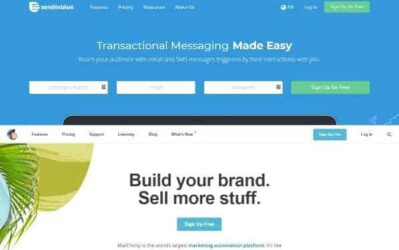










No Comments
Join the conversation
Leave a comment